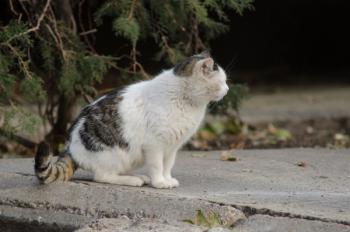
Clinical approach to icterus in the cat (Proceedings)
Icterus is a term used to describe the clinical appearance of hyperbilirubinemia. While reference values may vary, in most instances a serum bilrubin > 1 mg/dl is considered abnormal but clinically detectable icterus usually does not occur until the bilirubin is > 3 mg/dl.
Icterus is a term used to describe the clinical appearance of hyperbilirubinemia. While reference values may vary, in most instances a serum bilrubin > 1 mg/dl is considered abnormal but clinically detectable icterus usually does not occur until the bilirubin is > 3 mg/dl.
Bilirubin metabolism
Bilirubin is formed from the breakdown of hemoglobin (primary source), myoglobin and other proteins containing porphyrin. The cells of the mononuclear phagocytic system in the spleen, liver and bone marrow phagocytize damaged red blood cells. The red blood cells are broken down and hemoglobin released. Hemoglobin is broken down into heme and globin. Globin is converted to amino acids. Heme is broken down into iron and protoporphyrin. Protoporphyrin is converted to biliverdin and then bilirubin. Bilirubin is released from the phagocytic cells, attached to a transport protein and transferred into the hepatocytes of the liver through a saturable membrane transport system. Once in the hepatocyte, bilirubin binds to the protein ligandin, which prevents efflux back into the bloodstream. This bilirubin is then conjugated and most of it excreted into the bile canaliculi with much less moving into the bloodstream. Some of the bilirubin in the bloodstream remains unbound and passes into the urine but some is protein bound in circulation (biliprotein, delta bilirubin). This is why both conjugated and unconjugated bilirubin can be found in circulation. The conjugated bilirubin in the bile is excreted into the small intestine where bacteria convert it to urobilinogen. Almost all urobilinogen is excreted into the feces as stercobilin with only a small amount reabsorbed that either is taken up by the liver or excreted in the kidneys.
Pathophysiology
Hyperbilirubinemia can result from excessive bilirubin production (pre hepatic), impaired hepatic uptake/conjugation (hepatic) or decreased excretion (post hepatic). Excess bilirubin production is most commonly due to hemolysis but may also occur with extensive internal bleeding and breakdown of damaged red blood cells. With extravascular hemolysis bilirubin production occurs as described above but with intravascular hemolysis hemoglobin is free in circulation then complexes with haptoglobin and is removed by hepatocytes where hemoglobin breakdown occurs.
Hepatocellular dysfunction from decreased functional mass, poor perfusion or defects in uptake or conjugation can also cause hyperbilirubinemia and icterus. This occurs with inflammatory, infiltrative and necrotic diseases of the liver.
Decreased bilirubin excretion results from impaired bile flow outside of the liver. Inflammatory, infectious, neoplastic and obstructive diseases that affect the cystic duct, gall bladder, common bile duct, or duodenum can affect bile flow.
Differentials for icterus in the cat
Prehepatic
• Immune-mediated hemolytic anemia
- Secondary
o Mycoplasma haemofelis
o Feline leukemia virus
o Feline immunodeficiency virus
o Cytauxzooan felis
o Lymphoma
o Blood transfusion
o Pyruvate kinase deficiency
o Heinz body anemia
- Primary
• Hemolytic anemia
- Heinz body anemia
- Hypophosphatemia
Hepatic
• Cholangitis
- Neutrophilic
- Lymphocytic
- Mixed
o Fluke-associated
• Hepatic lipidosis
• Neoplasia
- Lymphoma
- Biliary carcinoma
- Hepatocellular carcinoma
- Biliary cystadenoma
• Sepsis
• Hepatitis
• Feline infectious peritonitis
• Toxin
- Acetaminophen
- Tetracycline
- Diazepam
- Ketoconazole
- Methimazole
- Phenols
- Aflatoxins
- Herbals
Posthepatic
• Cholecystitis
• Pancreatitis
• Inflammatory bowel disease
• Bile duct stricture
• Biliary carcinoma
• Biliary cystadenoma
• Liver fluke
• Biliary rupture
• Cholelithiasis
Diagnostic evaluation
The history can provide information related to possible drug exposure or a history of diseases that might predispose cats to cholangitis such as pancreatitis and inflammatory bowel disease. An overweight cat that develops anorexia and icterus is likely to develop hepatic lipidosis. The physical exam is not always helpful in differentiating causes of icterus. Fleas have been associated with Mycoplasma haemofelis. A fever may be found with inflammatory and infectious diseases. With hepatic lipidosis or hepatobiliary neoplasia the liver may be enlarged. Lymphoma may involve the intestinal tract and manifest as a palpable abdominal mass. Suppurative cholangitis, hepatitis, pancreatitis, and biliary peritonitis can result in abdominal pain.
Initial laboratory evaluation of an icteric patient includes a CBC, biochemical panel and urinalysis. This limited evaluation can be extremely helpful in targeting your differentials and diagnostic work up. The two things to look for first are the presence of anemia and involvement of the liver. If a moderate to severe anemia is noted, a reticulocyte count should be performed. A regenerative anemia should be noted with prehepatic causes of icterus. Unfortunately cats with chronic diseases and hepatic lipidosis can become moderately to severely anemic which can be confusing. Cats with hepatic lipidosis can also develop microcytosis. These disorders, however, should cause a non-regenerative anemia.
If a regenerative anemia is noted tests for the feline leukemia virus, feline immunodeficiency virus and the appropriate erythroparasites should be performed. Mycoplasma haemofelis is the most common hemotropic parasite that can cause severe hemolysis and immune mediated hemolytic anemia. Parasitemia may be intermittent so a PCR is indicated in cats in which organisms are not grossly visible on a blood smear. Cytauxzooan felis is another hemotropic protozoa found in the gulf coast region that causes severe, rapidly progressive, often fatal disease. The diagnosis is typically made with organism identification on blood smears or tissue aspirates. Primary immune-mediated hemolytic anemia is rare in the cat but the diagnosis is made by ruling out secondary causes of immune mediated hemolytic anemia and looking for aoutagglutination or performing a Coombs' test. Pyruvate kinase deficiency has been documented in several cat breeds and domestic short haired cats with an increased incidence in Somali and Abyssinian breeds. These cats develop recurrent strongly regenerative hemolytic anemias, icterus and elevated liver enzymes from a young age. Heinz bodies occur as a result of oxidative damage in red blood cells. Small numbers of Heinz bodies are normal in cats. Increased numbers of Heinz bodies may be seen in cats with hyperthyroidism, diabetes mellitus and lymphoma but their contribution to anemia is unknown in these diseases. Acetominophen toxicity can cause a Heinz body anemia in cats but icterus in these cats may also be due to liver damage.
While evaluating for anemia, liver enzymes should also be assessed. If there is no prehepatic component and elevation of alkaline phosphatase, alanine aminotrasferase and gamma-glutamyltransferase, hepatic involvement should be suspected. Unfortunately a lot of diseases in other body systems affect the liver and may cause elevations in liver enzymes. There are certain patterns in liver enzyme elevations that might suggest different hepatobiliary diseases. For example, with hepatic lipidosis ALP is most dramatically increased with lesser elevations in ALT and normal GGT. With cholangitis ALT and GGT are increased to a greater extent than ALP. Elevations in bilirubin alone can be seen in cholestasis secondary to sepsis. The most marked, or dramatic increases in bilirubin, are seen with a biliary obstruction.
Additional diagnostics to evaluate for liver disease might include bile acids, an abdominal ultrasound, bile cytology/culture and a liver aspirate/biopsy. A large hyperechoic liver is suggestive of hepatic lipidosis. With cholangitis the liver parenchyma is variable in appearance but there may be thickening of the gall bladder wall. Lymphoma can also have a variable appearance but is usually heterogenous and nodular. Primary liver tumors may appear as mass lesions. Biliary neoplasia can be cystic in the cat. The intra and extrahepatic biliary tree can be evaluated for distension and obstruction. Keep in mind that some older cats have dilation of their common bile ducts as a normal finding. Distension of intrahepatic ducts is more suggestive of a biliary obstruction. Choleliths are actually rare and infrequently cause obstruction of the common bile duct. Biliary tumors, cysts, inflammatory tissue and stricture are more common causes of obstruction. It is common to not be able to identify the source of obstruction in which case surgery may be necessary for diagnostic and therapeutic cases. Abdominal fluid may be found and due to primary hepatobiliary diseases such as cholangitis, hepatitis, hepatic neoplasia and biliary rupture. Abdominal fluid may also be seen with some of the conditions outside of the liver that can lead to icterus such as inflammatory bowel disease and pancreatitis. Ultrasound has additional benefits as far as evaluation of other abdominal organs (e.g. intestinal tract, pancreas, lymph nodes) and facilitation of samples for cytology and culture.
Liver aspirates are performed when neoplasia and hepatic lipidosis are suspected. Bile can be sampled for cytology and culture in cases of cholangitis. Cytology is helpful in differentiating suppurative from lymphocytic forms of cholangitis. Positive bile cultures are common with suppurative cholangitis. Care should be taken when considering biliary aspirates in cats with possible obstruction or an abnormal gall bladder wall because of possible rupture of the biliary tree and subsequent bile peritonitis.
Liver biopsies are necessary to definitively diagnose some diseases such as cholangitis, hepatitis, necrosis, feline infectious peritonitis, and occasionally with neoplasia. Biopsies also provide prognostic information. Biopsies can be taken under ultrasound guidance, laparascopically or surgically. Care should be taken when procuring tru-cut liver biopsies from cats. There are concerns about the use of fully automatic tru-cut biopsy guns in cats. It is suspected that contact with the biliary epithelium results in vagal stimulation, bradycardia, shock, and in some instances death. Biopsies tissue can be submitted for histology and culture. Testing for normal coagulation should be done prior to biopsy. Coagulopathies can occur with liver disease because of inadequate synthesis of clotting factors, inability to activate clotting factors and vitamin K deficiency due to cholestasis. For this reason coagulation should be assessed prior to biopsy. Even with normal coagulation, significant hemorrhage can occur.
Additional diagnostics that can be performed to evaluate for associated conditions include measurement of pancreatic lipase for pancreatitis, measurement of cobalamin and folate for evidence of small intestinal disease, intestinal biopsies for inflammatory bowel disease, and blood cultures for sepsis.
Treatment
Treatment should address the primary disease as well as be supportive. Supportive care might consist of fluid therapy to correct fluid deficits, maintain hydration and correct electrolyte and metabolic derangements. Antiemetics are used to help control vomiting. Blood transfusions are required in cases of severe anemia. Enteral nutrition, amino acids, antioxidants and cholorectics are recommended for hepatic lipidosis. Antioxidants and cholorectics are used with inflammatory liver disease and hepatic necrosis. Antimicrobials are required for Mycoplasma haemofelis, suppurative cholangitis and sepsis. Glucocorticoids (and other immunosuppressants) are used for immunosuppression with immune-mediated hemolytic anemia, lymphocytic cholangitis and inflammatory bowel disease. Chemotherapy utilizing a CHOP based protocol is recommended for lymphoma. Surgery may be required in cases of biliary obstruction. Biliary stenting or diversion may be required. Surgery is also required with biliary peritonitis. Surgery may also be utilized to resect focal tumors.
References
Elliot J. Jaundice in Textbook of Small Animal Internal Medicine. 7th ed. Ettinger SJ, Feldman EC (eds) Elsevier 2010 pp 287 – 9.
Liptak JM. Hepatobiliary tumors in Withrow & MacEwan's Small Animal Clinical Oncology 4th ed. Withrow SJ, Vail DM (eds). 2007 Elsevier. Pp. 483 – 91.
Lassen ED. Laboratory evaluation of the liver in Veterinary Hematology and Clinical Chemistry. Thrall MA (ed) Blackwell 2006. pp 355 – 375.
Thrall MA. Regenerative anemia in Veterinary Hematology and Clinical Chemistry. Thrall MA (ed) Blackwell 2006. pp 95 - 119.
Webster CRL. History, clinical signs, and physical findings in hepatobiliary disease in Textbook of Veterinary Internal Medicine. 7th ed. Ettinger SJ, Feldman EC (eds). 2010 Elsevier. Pp 1612 – 25.
Newsletter
From exam room tips to practice management insights, get trusted veterinary news delivered straight to your inbox—subscribe to dvm360.






